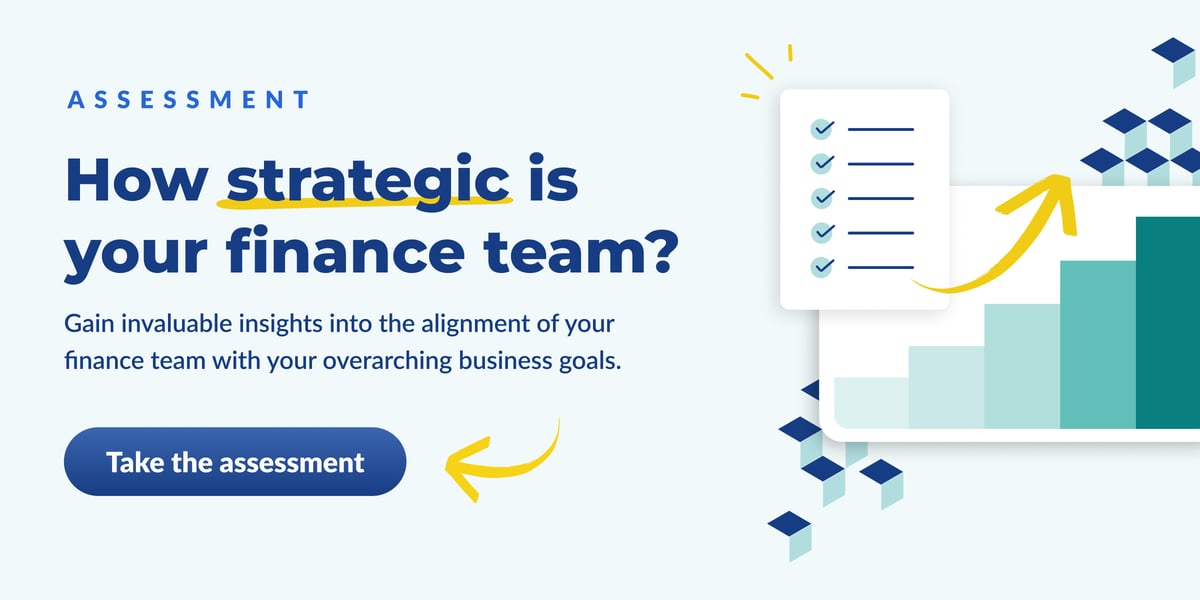The 5 strategic benefits of budgeting
It’s essential to start here because as every head of finance knows, budgets keep businesses moving forward strategically while minimizing financial surprises.
A successful CFO will link historical data to a financial budget that is accurate, timely, and easily understood; this will result in informed decision-making. Here’s a quick recap of the five key benefits of creating a robust budget:
- Aligns the business to critical strategic goals & priorities
- Helps measure performance throughout the year
- Enables the business to run scenarios and project the future state of the business
- Sets the stage for expenditures, including where to accelerate or cut
- Provides guidance for future performance both internally and externally

10 steps for a successful annual budgeting process
Creating a business budget is a real-time commitment. To be successful, it should be viewed as a project and treated as a formal planning process. Here are the steps to creating an accurate, actionable budget:
1. Set a timeline
Budgeting can be treated the same as any other project to be managed. The first step is to establish critical dates and work backward from when each step needs to be completed.
Keep in mind that budgets need to be reviewed and approved by the appropriate leaders before being implemented and the process is almost always iterative.
Take the necessary measures when setting the timelines to enable management the time to ask questions and make suggestions to the budget.
Fiscal year-end companies commonly aim to implement budgets at the start of the year on January 1st. To meet the goal, it’s standard to begin the budgeting process no later than October. Doing so allows enough time to get the budget reviewed and finalized.
2. Establish the strategic priorities
Discuss the goals for the budget and how they align with the business's strategic priorities for the following year. Budgets cannot be created in a vacuum – they must work in a way that brings the business closer to its objectives.
This is a great time to loop in senior management and other leadership team members. The budget strategy should be cohesive amongst all departments in the company, from marketing and sales to IT and purchasing.
More than anything, the budget must help push the organization into the future. It’s crucial that leadership at every level of the business understands how the budget expectations will play into their role within the company.
Additionally, leadership must communicate the budget goals and effectively manage their adoption to ensure all financial targets are hit.
3. Assign responsibilities
Assigning responsibilities is a vital part of the process to keep the budget moving forward as scheduled.
Ensure that every key stakeholder is included to evaluate who will be responsible for which tasks, like reviewing and approving the success of the current budget or compiling data into departmental reports.
It may help assign each budget team member a certain department to work with.
That way they can focus on one business function.
4. Forecast top-line scenarios
In building a plan, revenue or top-line projections should be considered first, as most of the expense planning (variable and fixed) will be based on revenue projections.
In companies where revenue is more difficult to predict, it’s a best practice to build multiple scenarios: a base case (most likely), a best case, and a worst case. Multiple forecasts and plans allow the business to more easily adjust up or down with resources as revenue plans shift throughout the year.
It’s also a best practice to plan cash around the “worst case”, set stretch goals around the “best case”, and communicate the most likely case around expenses and performance to the team.
If a business is trending towards the best case, then the best case expense budget can be used for additional growth, and if it’s trending towards the worst case, adjustments can be made quickly.
5. Estimate costs
Once the revenue plan is locked down, it’s easier to begin the process of budgeting business expenses. Start with predictable, essential costs such as rent and insurance. Then, focus on expenses that may relate directly to revenue growth, such as variable costs like inventory and supplies for production.
When thinking about workforce needs like headcount, be sure to account for all overhead costs by employee, such as benefits, computers, office expenses, travel, etc. Make sure to consider any raises or compensation programs that are in place when evaluating upcoming salary expenses.
Some of the best resources to get information on upcoming spending are department leaders. Chat with them early on about their team’s needs to help meet the established revenue targets.
Consider updated requirements for equipment or software, upcoming travel to conferences, or investing in a tangible tool (such as a subscription to purchase market research data).
Make it clear that this is a “wish list” but that it’s vital for upper management to understand and hear their ideas of what it might take to have a more favorable year. Buy-in and support from departments are crucial to this process.

6. Add capital expenses
Capital expenses should always be included in the budgeting process. It helps set the stage for which projects will be pursued in the upcoming year and which will have to wait.
Consider what expenses the business needs to incur to support the expected growth, including new equipment, vehicles, furniture, or upgrades to computer systems.
Be sure to incorporate the impact of depreciation and amortization schedules, as some expenses will hit the P&L in future years instead of the year in which the item is purchased.
7. Forecast cash flow
During the budget process, it’s necessary to forecast the business’s cash flow to understand when cash is expected to come in and when it should expect it to go out. With that information, the budget can be tweaked to ensure no shortages occur.
Companies use the projected cash flow figures for diving deeper into the predicted financial state of the business for the upcoming year. It creates a clearer picture of which months the company can expect to see a surplus of cash and which months they may fall into the red.
Using this data, organizations can plan to safeguard some cash from better months to cover and predict shortfalls at other times during the year.
Tip: Companies also use Burn Rate to understand the future financial state of the business. It’s a figure that shows how quickly a business is “burning through” its cash. Read more about it here.
8. Approve the budget
Once the budget has been finalized, it’s time for approval. Gather the key decision-makers, including senior leadership, to discuss and finalize the budget.
Explain the budget goals, how the goals align with the overall business strategy, and what decisions were made during the budgeting process.
Depending on the company culture, use supplemental materials to drive this discussion. With some C-levels, it’s best to use a snapshot view, while other leaders benefit from seeing the breakdowns of specific calculations in each category.
9. Document and implement
When everyone has signed off on the budget, formally document it and create an implementation plan. Each department head already interviewed in the early stages of this process should have a feeling of buy-in.
Their teams should be made aware of the expectations and guidelines and any repercussions they may face if they fail to hold their department accountable.
Most fiscal year-end companies introduce budgets at the start of the new year on January 1st. If it’s the first year that a business is creating a budget, there’s no need to wait for the new year to adopt it.
It’s more important to start utilizing the budget as soon as possible, learn the process, and note what changes may be needed next budgeting season.
10. Monitor and adjust
If the company expects the budget process to be successful and worthwhile, its performance must be monitored closely. Regularly measure actual financial results against the budget either on a monthly or weekly basis.
Look into variances between actuals and the budget to understand potential causes.
The budget is a living document; adjustments can be made throughout the year where appropriate and possible; common practice is to do a formal revised budget each quarter and perform a variance analysis against both the current version and the original forecast.
Annual budgeting keys to success
Be proactive
Crafting a budget is a long process and should be treated as such. Instead of rushing through it, be proactive, and give the team plenty of time to adequately prepare the budget. Budgets need to be discussed and approved before being finalized and implemented. If the company uses the fiscal year-end, starting by October will give the team enough time to work through everything and ensure it’s ready to go on January 1st.
Be realistic
It’s tempting to show colossal growth and minimal expenses on the budget. While that looks good on paper, it will only lead to trouble once the budget is implemented. The truth is, businesses need to spend some money to make money. Aim to use conservative numbers when creating the budget. The conservative numbers will be easier to stick to and help the business predict more accurate financial results.
Be inclusive
The budget team may not fully understand the nature of each business segment. Instead of assuming or guessing, make the budgeting process very inclusive. Ask for feedback from all areas of the business and gauge their expectations for the upcoming year.
Not only will it help create a more accurate budget, but it will also help increase adoption because each department feels that they’ve had a say in what is happening.
Assign budget owners
Accountability is key. Every budget line or area should have a specific “owner” who keeps expenses on track with the budget. It can be helpful to check in with the budget owners quarterly and review the budget against actuals. Budget owners should be able to explain the reasons for any variances. This keeps owners accountable for the numbers and can help keep the lines of communication open between the department leaders and the finance team.
Bring everything together
The budgeting process is a project and should include proper planning to be successful.
The goals for the budget should help move a company along its strategic trajectory and support the goals for the entire business. After all, a budget isn’t helpful if it stunts the company’s growth.
The biggest key to a successful budget is to measure results and hold those in charge accountable for the outcomes. Accountability can be the difference between a blown budget and achieving stretch goals.



.png)









.png)





.png)
.png)